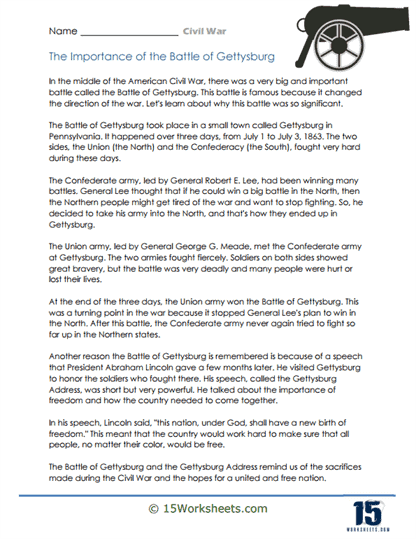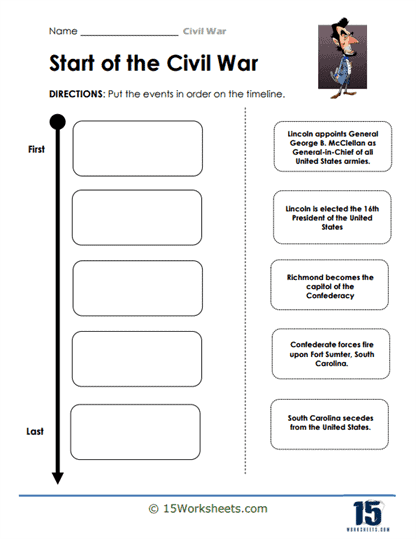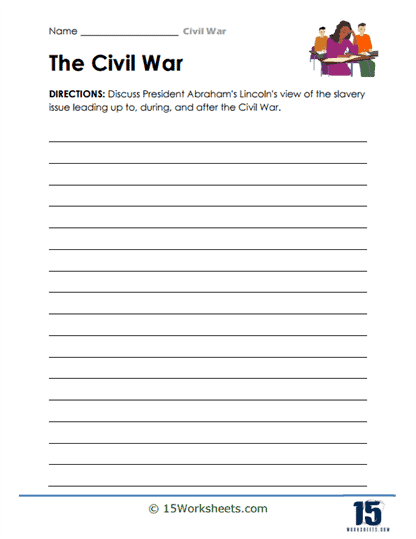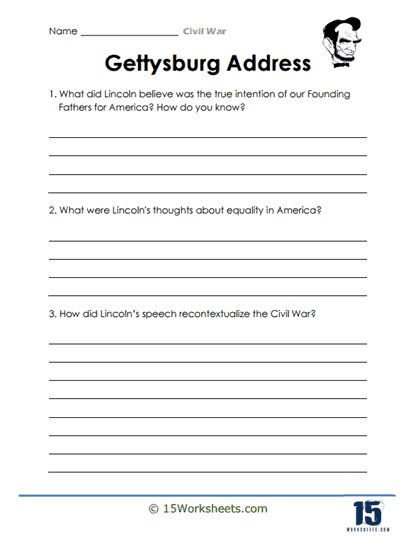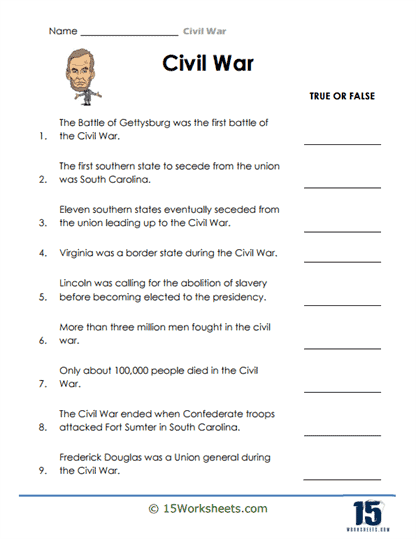American Civil War Worksheets
About These 15 Worksheets
The American Civil War was not just a chapter in American history-it was a turning point that forever changed the nation’s identity, its ideals, and its future. Spanning from 1861 to 1865, this brutal conflict, fought between the Union and the Confederacy, laid bare the deep divisions within a growing nation, while raising critical questions about freedom, equality, and governance. These worksheets, carefully crafted to capture the complexities of this era, provide students and learners with an in-depth exploration of the war’s key events, prominent figures, and enduring consequences.
More than just a battle over territory, the Civil War was fought over core principles that defined the nation’s very existence: the morality of slavery, the power of individual states versus the authority of the federal government, and the vision of what America could-and should-become. These themes are woven throughout our worksheets, inviting students not only to understand the historical facts but to grapple with the ethical and philosophical dilemmas that shaped the war. Through interactive exercises and engaging narratives, learners are encouraged to step into the shoes of the people who lived through these trying times, from soldiers on the front lines to politicians in heated debates, from enslaved individuals yearning for freedom to families torn apart by the conflict.
One of the critical aspects of these worksheets is their ability to cater to diverse learning styles and age groups. Younger students may begin by learning about the major battles-the bloodshed at Gettysburg, the siege of Vicksburg, the turning point at Antietam-but as they progress, they are invited to think more deeply about the human cost of the war. Older students can delve into the war’s broader implications: How did the Civil War redefine the American concept of liberty? What were the long-term effects on African American communities, both in the South and across the nation? How did the resolution of the war set the stage for the Civil Rights Movement nearly a century later?
Each worksheet is meticulously designed to encourage critical thinking. Rather than merely presenting facts, the exercises challenge students to ask questions: What could have been done to avoid the war? Was the conflict inevitable given the stark differences between the North and South? How did the war shape modern American politics, and what lessons can we draw from it today? These questions are not easily answered, but they push students to see history not as a distant story, but as a living, breathing force that continues to influence the present.
One cannot discuss the Civil War without acknowledging its profound impact on the fabric of American society. The end of slavery, symbolized by the Emancipation Proclamation and the passage of the 13th Amendment, marked a monumental step toward justice, yet the fight for true equality was far from over. These worksheets explore how the end of the war and Reconstruction efforts were both a victory and a missed opportunity-liberating millions of enslaved people but failing to secure lasting equality. The rise of Jim Crow laws, the disenfranchisement of Black Americans, and the long struggle for civil rights are all traced back to the unresolved tensions of this period.
Through a combination of historical narrative and interactive learning, these worksheets ensure that the Civil War is not simply remembered as a conflict between North and South, but as a pivotal moment that shaped the nation’s future. From Abraham Lincoln’s eloquent speeches to the personal stories of unsung heroes and heroines, the content captures the human side of the war, making it relatable and real for students. Learners are encouraged to examine primary sources, such as letters, speeches, and newspaper articles, to develop a more nuanced understanding of the time period.
Incorporating multiple perspectives is key to making this learning experience rich and engaging. By examining the experiences of Union and Confederate soldiers, abolitionists, enslaved people, women, and civilians, students gain a holistic view of the war. This approach not only fosters empathy but also emphasizes the war’s widespread impact on the entire nation-no family, no community, and no institution was left untouched.
These worksheets are a bridge to understanding how the past continues to shape our present and future. The lessons of the Civil War, from the importance of national unity to the ongoing fight for civil rights, remain as relevant today as they were over 150 years ago. Through thoughtful design, engaging content, and challenging exercises, these worksheets aim to inspire a new generation of thinkers who can reflect on the past and actively shape the future.
By examining the Civil War not just as a conflict, but as a crucial inflection point in the American journey toward justice, freedom, and equality, students are empowered to make connections to the struggles of today. Whether it’s understanding the roots of systemic racism, grappling with questions about federal power versus states’ rights, or simply appreciating the sacrifices made for a more just nation, these worksheets aim to cultivate a deeper appreciation for the complexities of American history. Through this exploration, learners are equipped with the knowledge and skills to contribute meaningfully to ongoing discussions about equality, justice, and unity in the modern world.
Types of Exercises
Timelines and Maps – Students might be asked to create or complete a timeline of major events leading up to, during, and following the Civil War. This provides a chronological perspective of the war’s progression. Using maps, students can identify significant battle sites, Union and Confederate states, and other key geographical points related to the war.
Multiple Choice Questions – These assess general knowledge, asking questions like “Who was the president of the Confederate States of America?” or “Where was the final surrender of the Confederate army?” Students can answer questions on various topics, ranging from the significance of a particular battle to the role of women during the war.
Biographical Sketches – Focusing on key figures such as Abraham Lincoln, Robert E. Lee, or Harriet Tubman, students can write or fill in details about their lives, contributions, and significance. Students can examine firsthand accounts, speeches, letters, or photographs from the era, answering questions or reflecting on the sentiments expressed therein.
Essay Prompts – Encouraging deeper reflection, prompts might ask students to discuss the causes of the Civil War, the role of slavery, or the effects of Reconstruction. Students might be guided to discuss contentious issues of the time, such as states’ rights versus federal authority or the moral implications of slavery. Worksheets may provide scripts or scenarios where students can enact key events, negotiations, or battles, offering an immersive learning experience.
The Value of These Worksheets For Students
The Civil War played a pivotal role in shaping America’s national identity. By studying it, students gain insights into the struggles and sacrifices that went into forging the nation they know today. As a central issue of the Civil War, understanding slavery is essential. It allows students to explore its socio-economic ramifications, its moral implications, and its lasting societal impacts, including the roots of systemic racism.
The post-war Reconstruction era brought about significant amendments to the U.S. Constitution, notably the 13th, 14th, and 15th amendments, which respectively abolished slavery, granted citizenship to all persons born in the U.S., and gave African American men the right to vote. Understanding these changes helps students appreciate the evolution of civil rights in the U.S.
Analyzing the varied causes of the war, the motivations of its participants, and the experiences of civilians helps students develop both critical analytical skills and empathy for those who lived through those tumultuous times. The repercussions of the Civil War are still felt today, from debates over Confederate monuments to ongoing dialogues about race and equality. By learning about the Civil War, students can better understand and engage in contemporary discussions.
The Civil War resulted in significant loss of life and devastation. By studying it, students can reflect on the costs of war and the value of diplomacy and dialogue. Delving into the Civil War requires students to engage with a range of primary and secondary sources, honing their research and analytical skills.
Beyond merely learning facts and dates, studying the Civil War encourages students to think critically about issues of race, governance, morality, and identity. In understanding this seminal event, students gain not only historical perspective but also a deeper appreciation for the complexities and challenges of the present day.
What Was the American Civil War?
The American Civil War, fought from 1861 to 1865, was a pivotal conflict in the United States’ history, marking a defining moment in the nation’s evolution. It was a civil war between the Union (the northern states) and the Confederacy (the southern states that seceded from the Union). This war was rooted in deep economic, political, and social differences between the North and the South, most notably over the issue of slavery and its expansion into new territories. By the end of the war, over 600,000 soldiers had died, and the course of American history was forever altered.
Why It Happened
The Civil War had multiple underlying causes, but the most significant was the institution of slavery. The South’s economy was heavily dependent on slave labor, particularly in the agricultural sector, with cotton being the most lucrative crop. The North, on the other hand, had a more industrialized economy and was increasingly viewing slavery as morally and politically unacceptable. As new states were admitted to the Union, the balance of power between free and slave states became a flashpoint, with both sides fiercely contesting whether these new territories would permit slavery.
States’ rights was another key issue. Southern states believed that they had the right to govern themselves without interference from the federal government, especially when it came to decisions regarding slavery. When Abraham Lincoln was elected president in 1860 on an anti-slavery platform, Southern states saw this as a direct threat to their way of life and began to secede from the Union, leading to the outbreak of war.
Key People
The Civil War featured several prominent leaders who shaped the course of the conflict. Abraham Lincoln, the 16th President of the United States, led the Union with a commitment to preserving the nation and ending slavery. His Emancipation Proclamation in 1863 was a turning point in the war, officially making the abolition of slavery a war goal.
On the Confederate side, Jefferson Davis served as the President of the Confederacy. Robert E. Lee, the leading Confederate general, became famous for his strategic prowess and leadership in key battles, despite ultimately being on the losing side. For the Union, Ulysses S. Grant emerged as the commanding general who would lead the North to victory. His relentless tactics and ability to win decisive battles earned him the title of General-in-Chief of the Union armies.
Major Battles
The Civil War featured several critical battles that determined the war’s outcome. The first major clash was the Battle of Bull Run (Manassas) in 1861, which shattered any illusions of a quick war. The Battle of Antietam in 1862 remains the bloodiest single day in American military history, with over 22,000 casualties, and it gave Lincoln the momentum to issue the Emancipation Proclamation.
The Battle of Gettysburg in 1863 was a turning point in the war, with the Union forces repelling Lee’s invasion of the North. It is often considered the “high-water mark” of the Confederacy. In the West, General Grant’s victory at Vicksburg was crucial, as it gave the Union control of the Mississippi River, effectively splitting the Confederacy in two. The war came to a close after a series of Union victories, culminating in Lee’s surrender to Grant at Appomattox Court House in April 1865.
The Human Cost
The Civil War was the deadliest conflict in American history. Over 600,000 soldiers died, with some estimates going as high as 750,000 when factoring in disease and non-combat-related deaths. Beyond the death toll, countless more were wounded, many with life-altering injuries. The war also had a tremendous social and economic impact. In the South, much of the infrastructure was destroyed, and the economy was devastated. Families were torn apart, and the scars of the conflict would linger for generations.
On the civilian side, the war uprooted communities, especially in border states and areas where battles occurred. Women took on new roles, managing farms and businesses, and in some cases, even serving as nurses and spies. The end of the war also left formerly enslaved people in a precarious position, as the Reconstruction era that followed struggled to define their new status and rights.
Why the War Was Important
The American Civil War was a defining moment in the nation’s history. It not only settled the issue of secession, firmly establishing that states could not leave the Union, but it also led to the abolition of slavery in the United States. The 13th Amendment, ratified in December 1865, officially outlawed slavery across the country.
The war also accelerated the shift towards a more centralized federal government, laying the groundwork for the modern United States. The victory of the Union ensured the preservation of the nation and set the stage for the United States’ emergence as a global power in the following century. However, the war’s legacy also included deep-seated racial tensions that persisted long after the fighting ended, shaping American society and politics in profound ways.
In short, the American Civil War was a transformative event that resolved critical questions about the future of the United States, from the fate of slavery to the very nature of the Union itself. Its aftermath shaped the country’s identity and trajectory, with effects that are still felt today.



